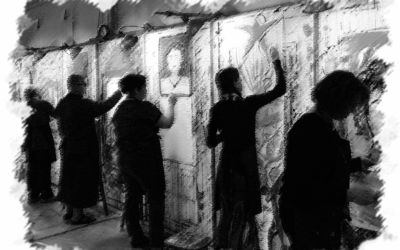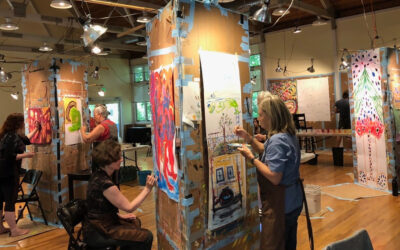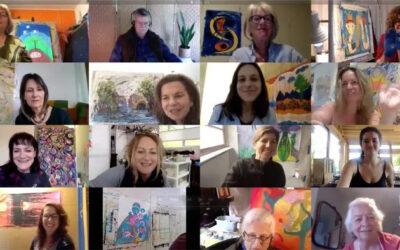
As this language speaks through us and despite us in the mysterious magic of the painting process, we come to appreciate more and more the boundary-less nature of our potential presence in the world.
Over time, I’ve noticed that certain essential forms mysteriously appear again and again in the painting process. From black hands to twisting vines, from blood to water to stars — it’s as if some universal commonality of images, shapes and colors exists upstream of conscious thought, a dialect spoken from the deepest recesses of the soul. What is this language of the imagination; what are these archetypes that repeat themselves with such uncanny regularity? Black hands, for example, appear again and again in the painting process. At a certain point — often after a period of blockage — they emerge from in back of a figure or from the boundaries of the paper and wrest control of the painting in a strong wave of passionate expression that releases some gathering tension. There seems to be a universality to black hands, a reality that transcends any interpretation. Their meaning, although precise and relevant, is experiential and uniquely suited to the particular needs of the moment. Their meaning is in their doing.
Vines commonly appear, often just prior to the completion of a painting. All of a sudden they want to entangle everything until there’s nothing left to wind around. We feel a delicious satisfaction when we finally give permission to these long stringy shapes. It might be ropes or nets or chains or veins instead of vines — any image that carries the feeling of entanglement and connection — and the color varies depending on the need. The mind can have a heyday with any recognition of this sort, hungry as it is for organizing and systematizing. But the temptation to conceptualize inevitably brings disconnection.
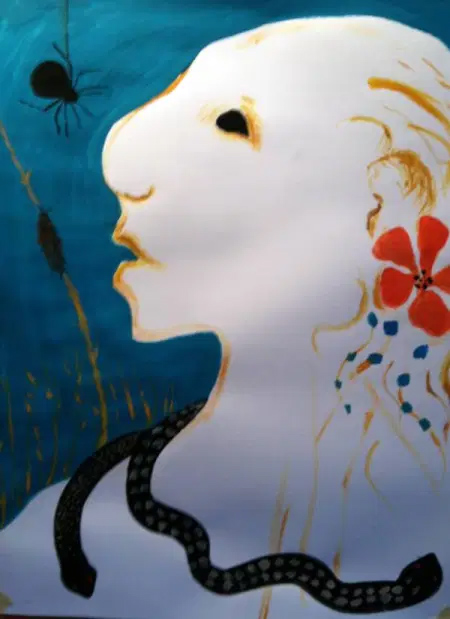 Snakes, spiders, worms and bugs of all stripes are important denizens of this inner landscape, injecting a certain distaste and squeamishness. Blood, excrement and various body fluids allow contact with the reality of human viscera so deeply rooted in collective memory. Fire, lightening, and explosive forces appear in reds and oranges or black, under many different sets of circumstances, bringing new energy and power that spark awareness. Water flows, tears pour forth, lava erupts. The earth appears with regularity, often revealing the curvature of its body, sometimes encompassing the entire globe. The universe of the deep night sky, full of stars, planets and galaxies insists on being included. Implements of destruction — knives, spears, axes, arrows and bombs — come shockingly forth in their violence. This language of forms is not a matter of preference or personal desire. They rudely crash their way onto the scene despite the best efforts to legislate them out of existence.
Snakes, spiders, worms and bugs of all stripes are important denizens of this inner landscape, injecting a certain distaste and squeamishness. Blood, excrement and various body fluids allow contact with the reality of human viscera so deeply rooted in collective memory. Fire, lightening, and explosive forces appear in reds and oranges or black, under many different sets of circumstances, bringing new energy and power that spark awareness. Water flows, tears pour forth, lava erupts. The earth appears with regularity, often revealing the curvature of its body, sometimes encompassing the entire globe. The universe of the deep night sky, full of stars, planets and galaxies insists on being included. Implements of destruction — knives, spears, axes, arrows and bombs — come shockingly forth in their violence. This language of forms is not a matter of preference or personal desire. They rudely crash their way onto the scene despite the best efforts to legislate them out of existence.
Death appears over and over in many contexts and guises. Bones, skeletons, cemeteries and funerals hold forth despite our bafflement over their arrival. Demons, monsters and dragons populate their dark caves with impressive pomp and entitlement, bespeaking an ancient reality that’s at once both playful and dangerous. Angels, ghosts and spirits emerge from the netherspheres, fulfilling their other-worldly assignments with amusing diligence. Cracks and fissures appear in the most well constructed figures, revealing their vulnerability and transience. Chaos descends in a previously ordered scene, disrupting our best intentions for neatness.
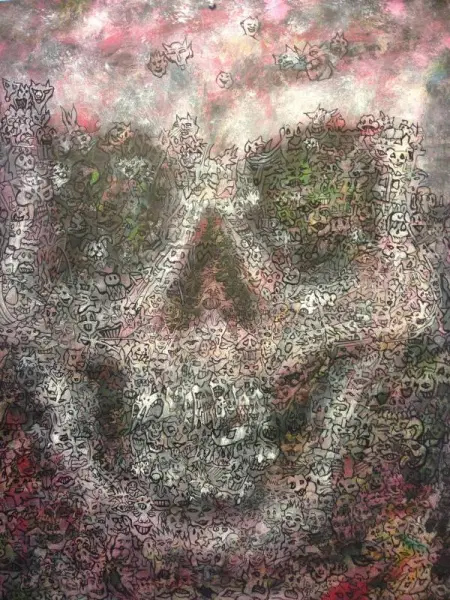 Then there’s the endless succession of dots, lines, squiggles and various undefined marks and shapes that maddeningly infiltrate every corner of the painting. Figures and abstract shapes intermingle, frustrating our attempts to keep the painting confined to a particular category. The size expands without warning, capriciously demanding to take a form bigger than life. Holes develop in things revealing what’s behind and underneath, roots reach down and out in ever-increasing detail, eyes suddenly appear in what at first seemed inanimate and lifeless.
Then there’s the endless succession of dots, lines, squiggles and various undefined marks and shapes that maddeningly infiltrate every corner of the painting. Figures and abstract shapes intermingle, frustrating our attempts to keep the painting confined to a particular category. The size expands without warning, capriciously demanding to take a form bigger than life. Holes develop in things revealing what’s behind and underneath, roots reach down and out in ever-increasing detail, eyes suddenly appear in what at first seemed inanimate and lifeless.
Personages of all types strut across the stage. Mothers and fathers inevitably make their debut at a certain point, along with siblings, grandparents, husbands, wives, lovers and other unnamed personalities. The gods arrive, not wanting to be left out of this grand cosmology, some as recognizable historical figures, others as mysterious spiritual presences. Sexual acts abound, the erotic taboo embarrassingly leaping to the fore with its unabashed appetite. And of course the self, the “me” is always there in one form or another, ever vying for the center of attention.
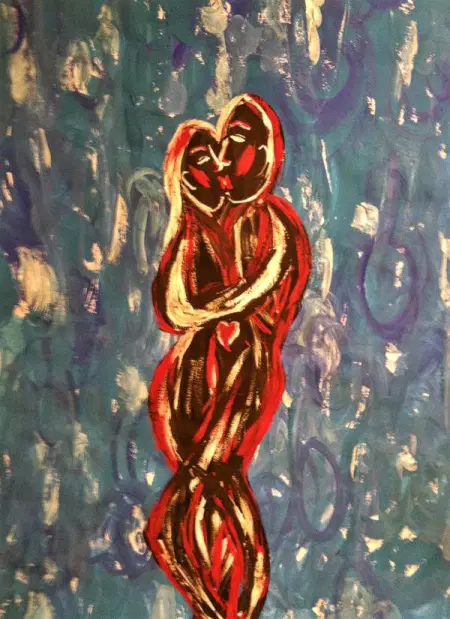 Speaking this archetypal language of image, form and color is like drinking from the source of a great wild river — exhilarating and surprising beyond imagining. And it quickly becomes clear that the mind is too pedantic to be invited to this party. This is the direct language of unrestrained celebration and risk, it pushes the edges of the acceptable in all directions, joyful as well as of distressing. Its purpose is to teach us to experience reality without the constraining chains of overbearing structure. It wants nothing less than total surrender to its powerful healing current. Each essential form when followed through to completion reveals our narrowly prescribed world to be only a shadow of the full spectrum of experience available. As this language speaks through us and despite us in the mysterious magic of the painting process, we come to appreciate more and more the boundary-less nature of our potential presence in the world.
Speaking this archetypal language of image, form and color is like drinking from the source of a great wild river — exhilarating and surprising beyond imagining. And it quickly becomes clear that the mind is too pedantic to be invited to this party. This is the direct language of unrestrained celebration and risk, it pushes the edges of the acceptable in all directions, joyful as well as of distressing. Its purpose is to teach us to experience reality without the constraining chains of overbearing structure. It wants nothing less than total surrender to its powerful healing current. Each essential form when followed through to completion reveals our narrowly prescribed world to be only a shadow of the full spectrum of experience available. As this language speaks through us and despite us in the mysterious magic of the painting process, we come to appreciate more and more the boundary-less nature of our potential presence in the world.
More Information
This article was originally published as “Drinking from the Source,” by Stewart Cubley.
To learn more about the practice of process painting, we recommend Stewart’s monthly Podcast series.
To see our schedule of upcoming process painting workshops and retreats, visit our Programs page.

